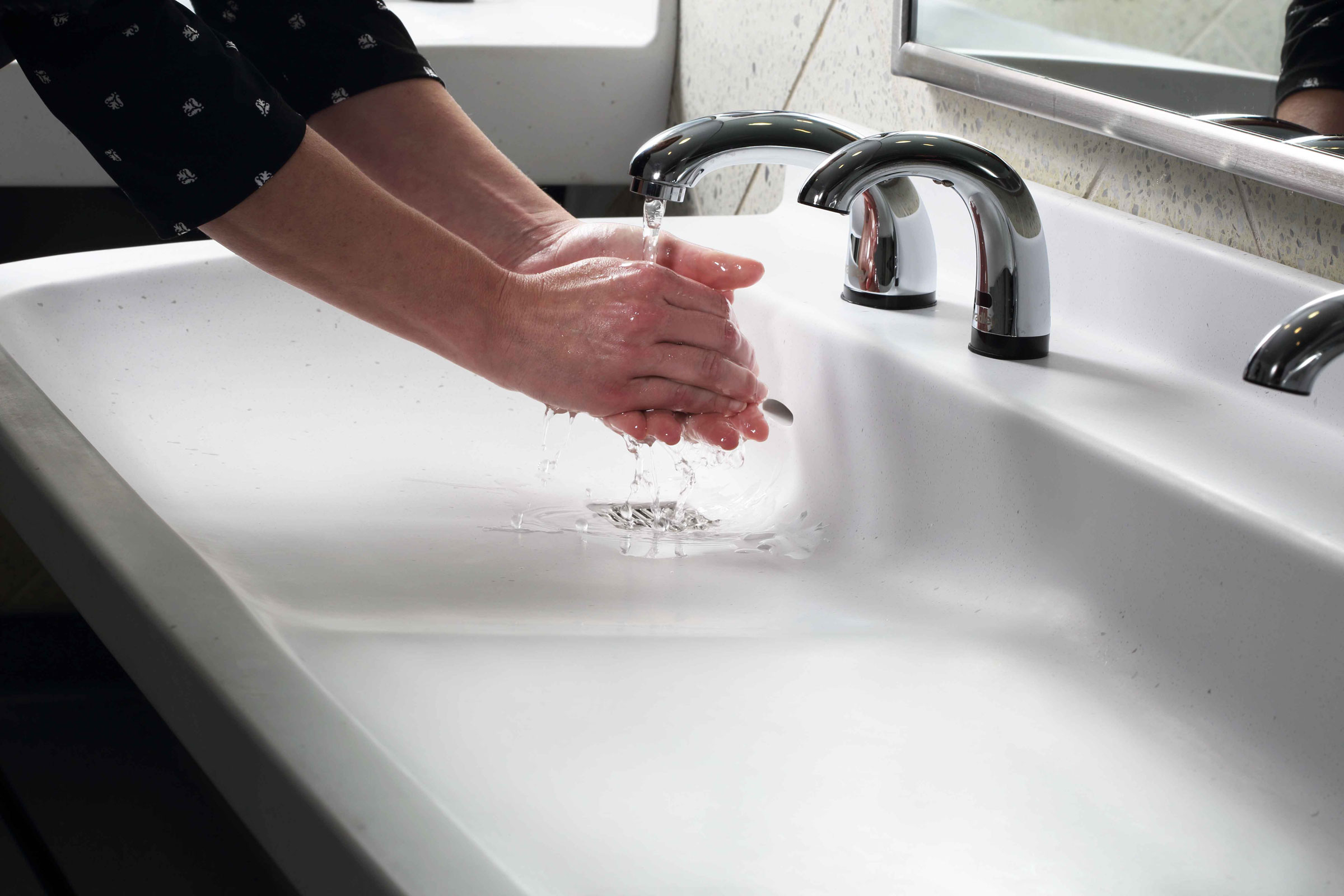Story at a glance:
- Hand dryers can have up to a 75% reduced carbon footprint compared to paper towels.
- With enhancements, traditional HVAC units can improve air filtration.
- Copper and silver are natural antimicrobial surfaces.
Perhaps now more than ever before, knowing how to design a hygienic bathroom is crucial for architects and builders. The Covid pandemic brought hygiene to the forefront of everyone’s minds, and places like bathrooms should respond to those concerns with touchless technology, improved air quality, and more.
Beyond feeling safe and hygienic, architects are looking to design bathrooms that are easy to keep clean and aesthetically pleasing, too. Messes caused by wet hands or used paper towels can be avoided with the implementation of products like a hands-free faucet or hand dryer. These hygienic solutions can also be eco-friendly.
Here are 10 tips to design a clean and safe bathroom.
1. Choose seamless flooring materials.
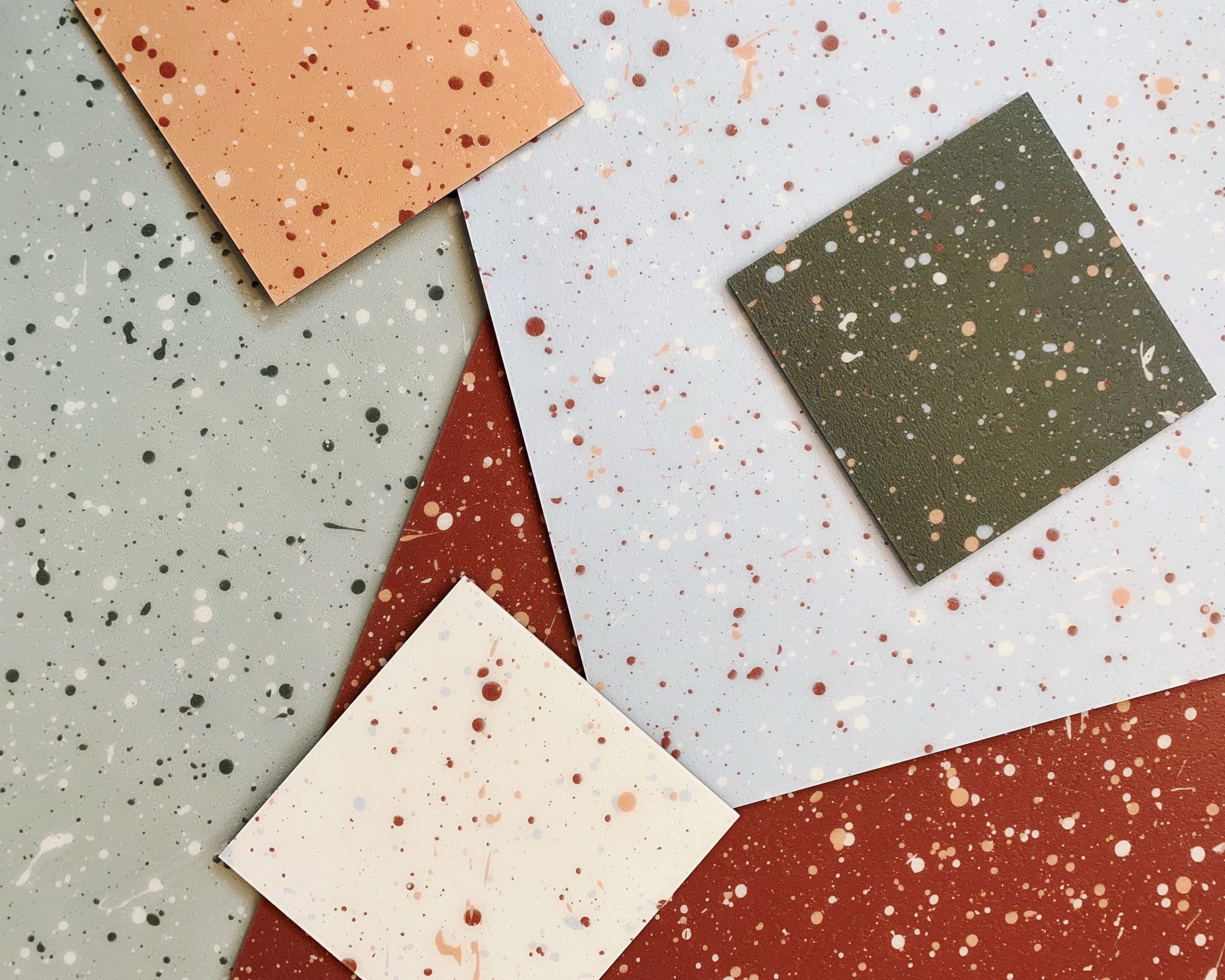
Selecting seamless, grout-free flooring products like luxury vinyl tile can help eliminate a major habitat for bathroom bacteria. Photo courtesy of Tarkett
Tile floors are an incredibly popular option for both commercial and residential bathrooms, in large part thanks to their durability and water resistance, but they can actually contribute to poor hygiene conditions if they aren’t maintained properly. This is due to the fact that tile flooring requires grout to be poured in the seams between each individual tile. Grout is a porous material that absorbs moisture and has a tendency to accumulate germs like staphylococcus and streptococcus.
The buildup of these germs on bathroom floors can be avoided altogether by choosing seamless flooring materials without lines or joints. Luxury vinyl planks (LVP), for example, are an excellent choice for washrooms as they are highly moisture-resistant, feature a waterproof wear layer, and fit seamlessly together with one another.
2. Incorporate UV sanitation.

BobrickPure’s constant sanitization technology uses targeted ozone, superoxide ions and hydroxy radicals to create an environment hostile to microorganisms. Photo courtesy of Bobrick Washroom Equipment
A device that uses light to sanitize an entire restroom may sound like something out of a science fiction novel, but thanks to Bobrick Washroom Equipment, it’s a budding reality. The PureSphere Air Sanitizer is a 24/7 hygiene solution for air and indoor surfaces that combines photocatalytic disinfection, germicidal irradiation, and dual waveband UV light to destroy microorganisms, neutralize and sanitize viral particles, and purify indoor spaces.
“Suitable for all rooms and occupied areas, including restrooms, lounges, and other spaces throughout your facility, the PureSphere Air Sanitizer provides complete workspace hygiene by sanitizing areas up to 323 square feet,” David Leigh, vice president of marketing for Bobrick Washroom Equipment, previously wrote for gb&dPRO.
Bobrick’s PureSphere Air Sanitizer is proven to inactivate 98.11% of airborne and 99.6% of surface microorganisms, including particles under 0.3 microns, making the device more effective than even the best HEPA filter. Testing has shown PureSphere to be capable of rendering everything from influenza and coronavirus to E. coli and staphylococcus inert, reducing particle presence by as much as 33%.
3. Opt for automatic or hands-free doors.
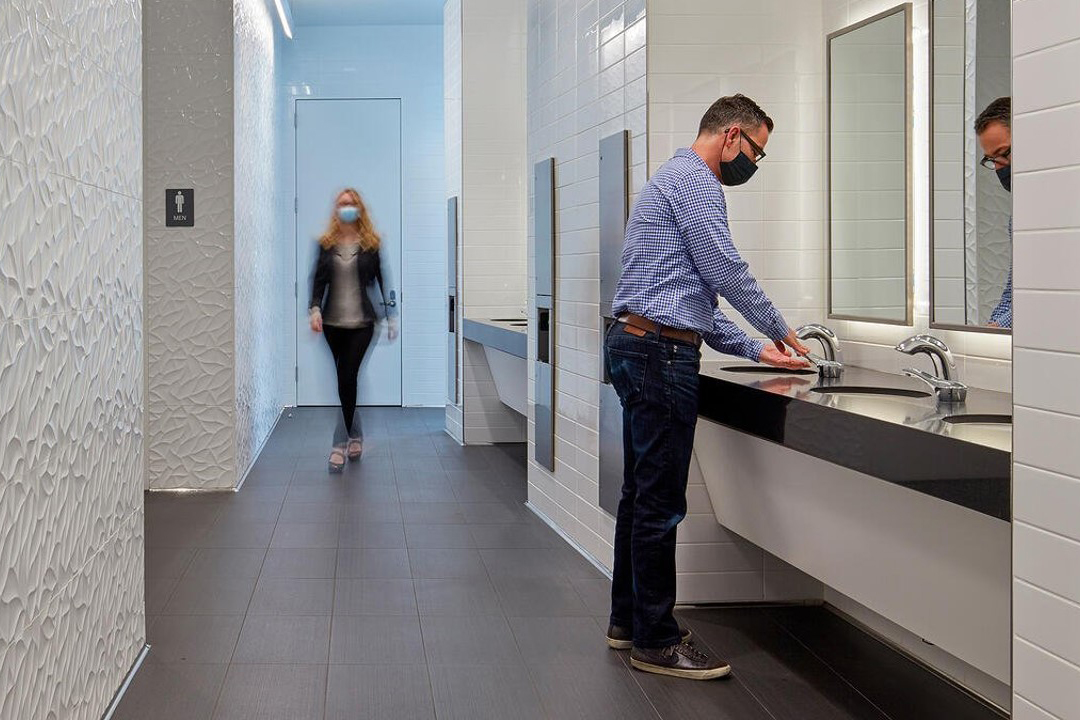
Choosing automatic or hands-free doors helps eliminate bathroom touch points and reduces the spread of germs. Eliminating entry/exit doors altogether can also help improve restroom hygiene. Photo courtesy of Bobrick Washroom Equipment
It is a common misconception that toilet seats are the dirtiest part of a restroom—but in reality, door handles may be the worst offender. A study conducted by IronMongeryDirect found that internal bathroom door handles average 93 bacteria colonies per cm2 of surface, or almost eight times that of the average toilet seat.
When it comes to bathroom entry/exit doors, opt for hands-free options that don’t require the user to make skin contact with any part of the door. This can be as simple as hanging push-to-open doors (for doors that open outward) or installing arm/foot-pull devices (for doors that swing inward), or as high-tech as an automatic door system that uses sensors or a button to open.
Depending on the bathroom layout, it may even be possible to eliminate the door entirely, completely removing a major source of germs from the equation altogether and reducing restroom maintenance requirements.
4. Install high-efficiency exhaust fans.
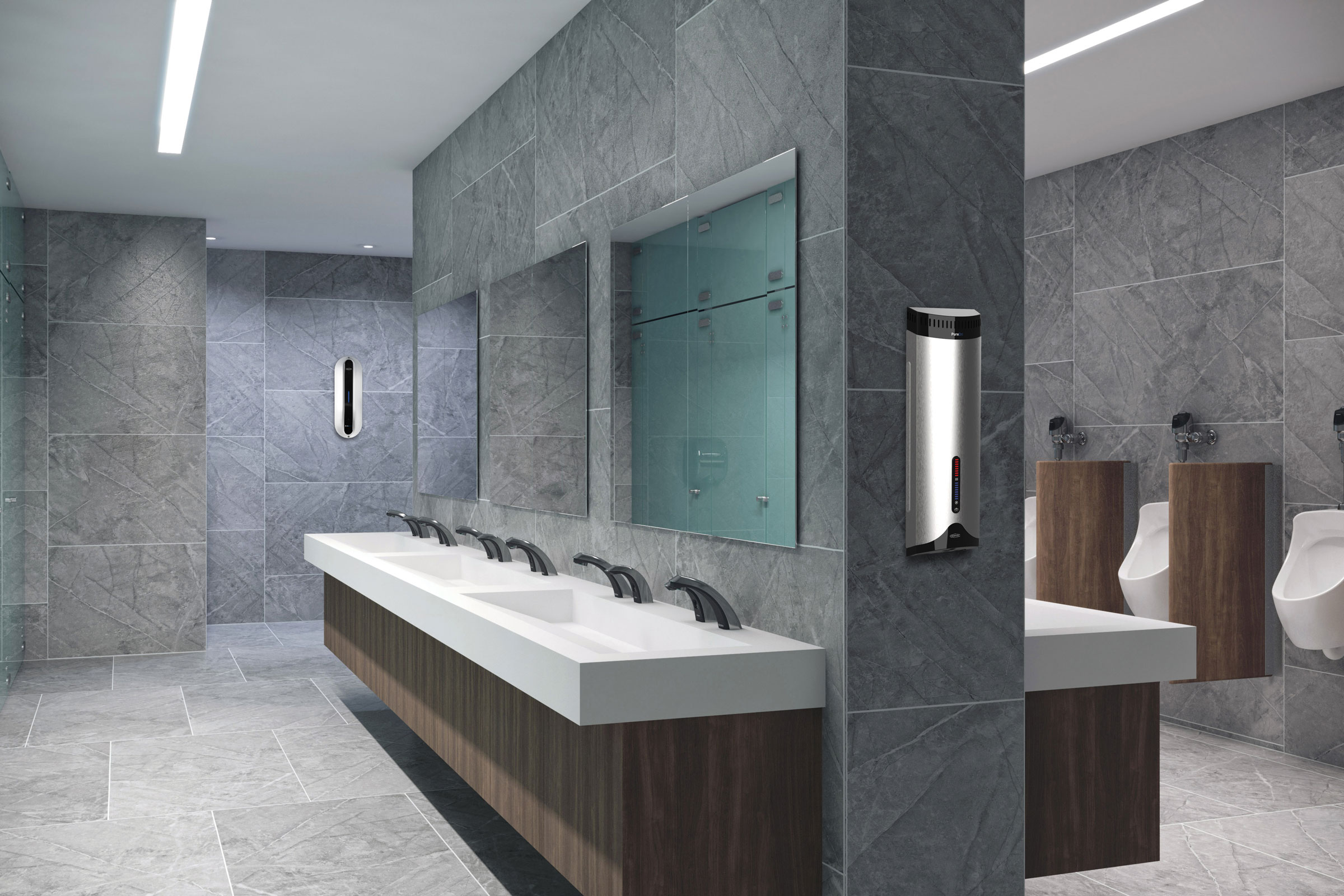
High-efficiency exhaust fans can help combat moisture buildup in restrooms, reducing the risk of mold, mildew, and bacteria growth. Photo courtesy of Bobrick Washroom Equipment
Bathrooms—both public and private—typically contain the most moisture of any room in a building, especially if they contain showers, one of the most common sources of indoor condensation. Moist, damp environments provide the perfect conditions for bacteria to thrive, but also increase the risk of mold and mildew growth.
And while it’s true that all bathrooms are required by code to include some form of exhausting mechanism—be it a fan or window—for dealing with this moisture, not all exhaust systems are created equally.
The most effective means of mitigating moisture buildup is via high-efficiency exhaust fans that transfer warm, humid air outside through their own dedicated ventilation ducts separate from a building’s central air or HVAC system. This helps prevent cross-contamination and ensures that moisture is quickly removed from the interior, greatly reducing the risk of mold and mildew growth as well as other types of moisture-related damage.
5. Choose touchless hand dryers.
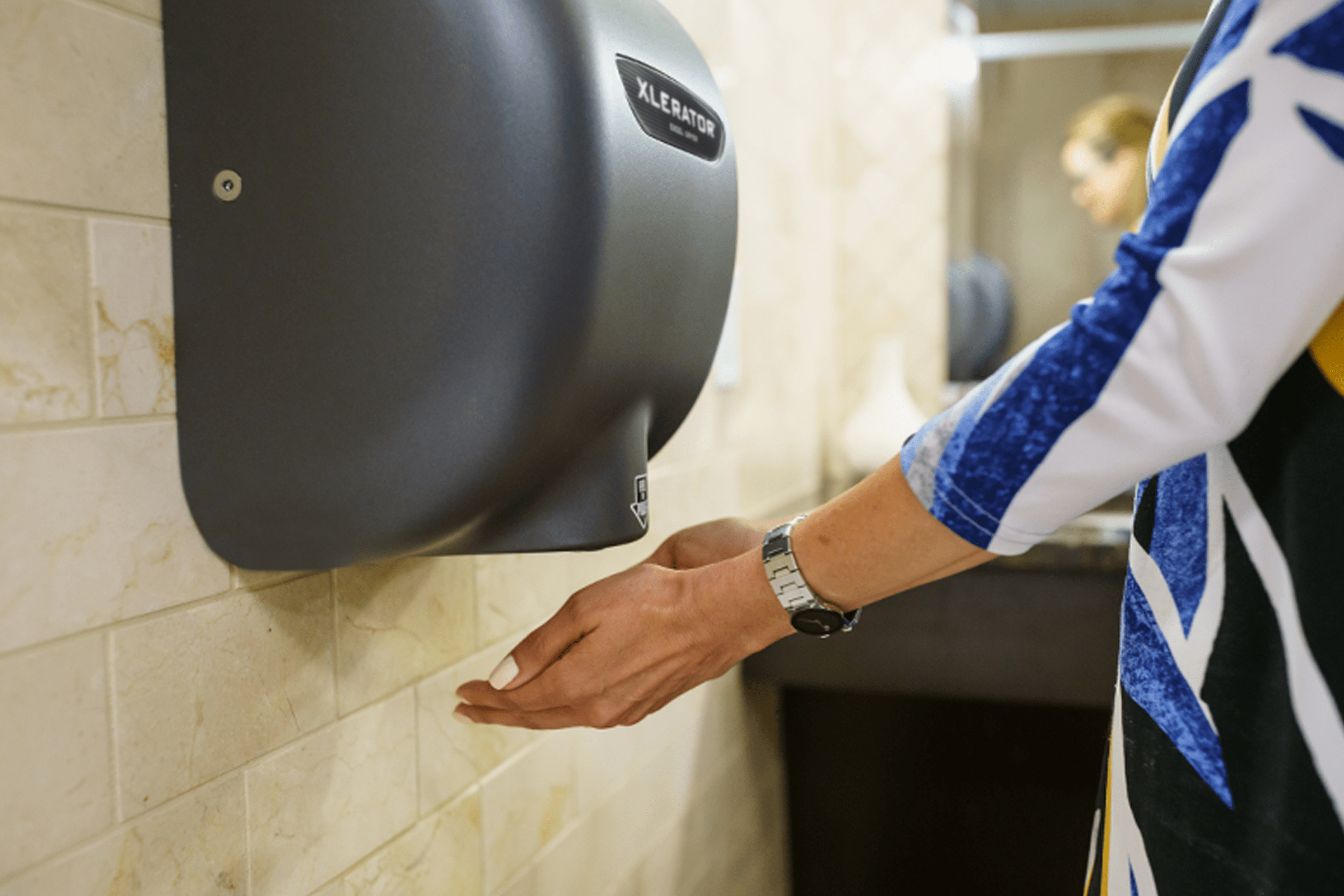
Experts from the World Health Organization state that proper hygiene is the best defense against the spread of germs, including coronavirus. Photo courtesy of Excel Dryer
Removing the need to touch a stack of paper towels or faucet heads can instantly improve a bathroom’s cleanliness and spread of germs.
When it comes to hand drying, experts recommend offering a mix of both hand dryers and paper towels. A recently published research study found hand dryers and paper towels to be equally hygienic. However, the waste and all-too-common mess caused by used paper towels makes hand dryers a more appealing option for new bathroom designs.
A touchless hand dryer is not only sanitary, but it also creates a tidy restroom environment, giving visitors peace of mind. Excel’s XLERATOR® hand dryer has a 75% reduced carbon footprint compared to paper towels and traditional hand dryers. Plus, Hand dryers eliminate the mess of paper towels and reduce the number of touchpoints in a restroom.
Building owners can up the cleanliness of hand drying even further with Bobrick Washroom Equipment’s PureDri Sanitizing Hand Dryer, a restroom device that “protects hands with a blast of super-concentrated ionized air following the drying cycle, while providing constant sanitization to the room itself,” writes Leigh.
PureDri uses the same technology as the PureSphere Air Sanitizer and is clinically proven to improve hand hygiene—delivering an up to 26% reduction in E. coli from surfaces following exposure—while also sanitizing an area of up to 215 square feet.
6. Actively combat against infection.

HVAC units alone can improve indoor air quality, but enhancements UVGI or BPI systems can take air filtration to the next level. Photo courtesy of LG VRF
Throughout the pandemic, health care facilities have been attaching bacteria-killing enhancements to HVAC units to combat airborne viruses and bacteria. “Traditional HVAC provides passive help through improved air filtration. Further enhancements maintain ultraviolet germicidal irradiation (UVGI) or bio-polar ionization (BPI) systems within AHUs or ductwork,” HEAPY‘s Brian Arbogast and Daric Hess previously wrote for gb&d.
BPI devices are installed in the HVAC unit. An electronic charge from the device generates a plasma field that’s dispersed through the system. This plasma attaches to viruses, bacteria, and gasses to trap them or settle faster than they would have, thus reducing both airborne and surface contaminants.
Another promising technology is the dry hydrogen peroxide system (DHP). A powerful oxidizing agent, hydrogen peroxide is capable of breaking down bacteria, viruses, and other organic compounds into oxygen and water, the latter of which leaves behind pure oxygen upon evaporation. DHP can be integrated into an AHU system and dispersed throughout an occupied space via the air system, where it not only removes contaminants from the air but from surfaces as well.
7. Choose antimicrobial surface materials.
While the CDC now reports that it is unlikely for you to pick up Covid from surfaces, having clean surfaces in a bathroom can’t hurt—especially considering some illnesses, like norovirus and salmonella, can survive for several days on hard surfaces.
Metal ion products like pure silver and copper have been shown to be effective against bacteria and certain viruses. Studies show the COVID-19 virus can survive on copper up to four hours versus stainless steel, which can carry the virus for 10.
Both soapstone and quartz surfaces are highly resistant to bacteria and stains because they are nonporous.
Various textiles, paints, and laminates offer antibacterial finishes—but be mindful, the antimicrobial qualities of these materials are intended to preserve the products’ surface from damage caused by microorganisms rather than prevent the spread of infection, Dianne Dunnell, former director of interior design at Margulies Perruzzi, previously told gb&d.
The best bet when it comes to an antimicrobial surface is to go with copper, silver, soapstone, or quartz.
8. Go hands-free for faucets and fixtures.
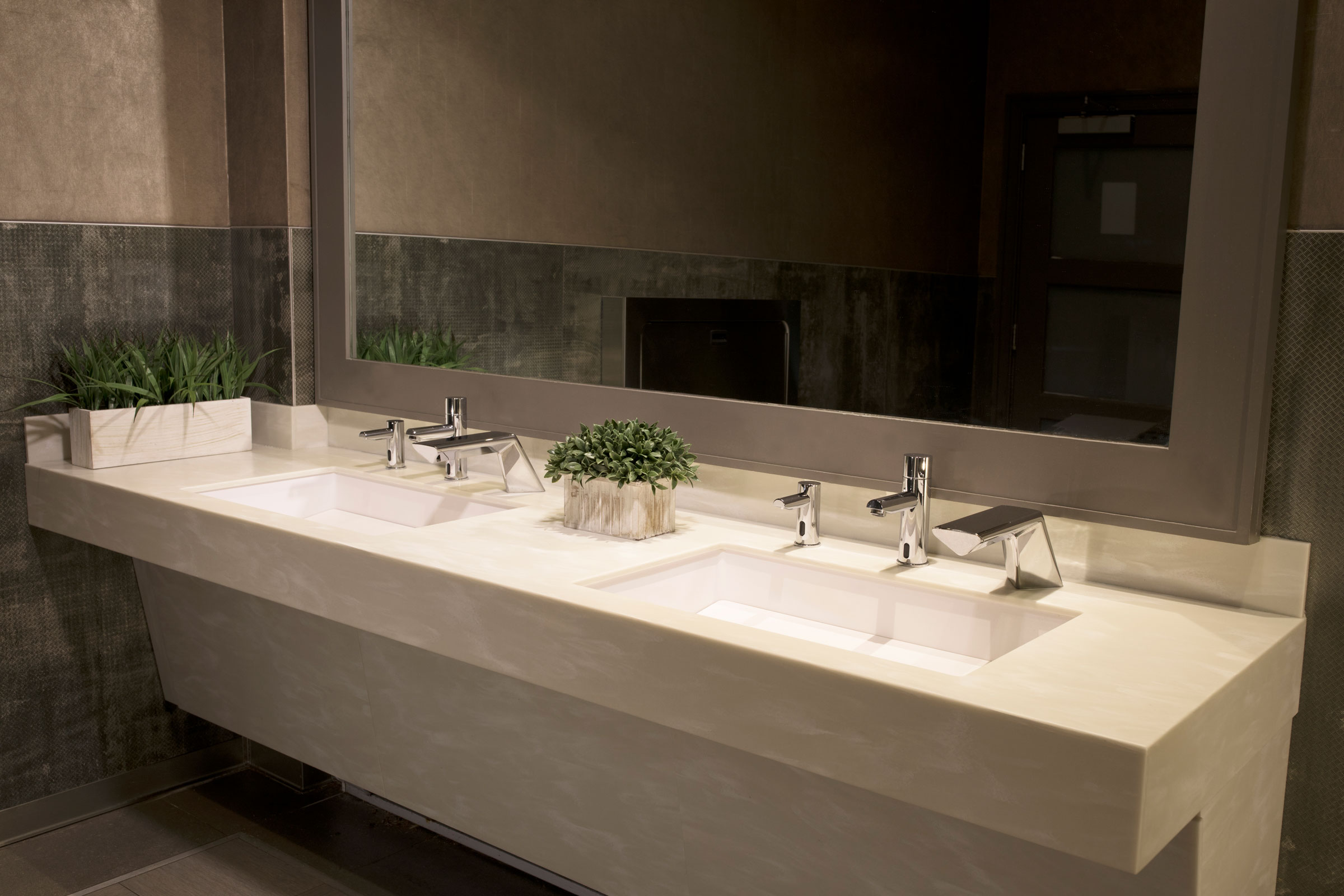
XLERATORsync, a component in the D|13 Sink System by D|13 Group, fuses no-touch, high-efficiency fixtures on the sink deck and allows users to complete the entire handwashing and drying process in one location. Photo courtesy of Excel Dryer
Bradley Corp. produces touch-free bathroom products for public restrooms. Their products range from hands-free soap and sanitizer dispensers to touchless sinks.
In August 2020 Bradley conducted a survey of 1,000 high school students and found that 50% of the students considered their schools’ restrooms to be fair or poor.
Bradley’s first product, a foot activated water fountain, was released in 1921. “The whole concept of touch-free metered water and saving water, that’s not something we started because other companies were starting to go green or because of Covid; we’ve been doing this a very long time,” Will Haas, senior product manager at Bradley, told gb&d in a previous interview. “The design trend overall in restrooms is going to work to eliminate every single touchpoint possible. That’s top of mind for designers.”
For the ultimate hands-free experience, opt for the D|13 Sink System, an all-in-one hygienic restroom product that combines the soap dispenser, water faucet, and hand dryer into a completely touchless 30’-wide station. Developed by D|13 Group, this novel sink system makes use of Excel Dryer’s high-speed, energy efficient XLERATORsync® hand dryer and features a V-shaped sink that diverts airflow into the drain, allowing users to effectively wash and dry their hands in less than 30 seconds.
9. Set boundaries with cubicles and partitions.
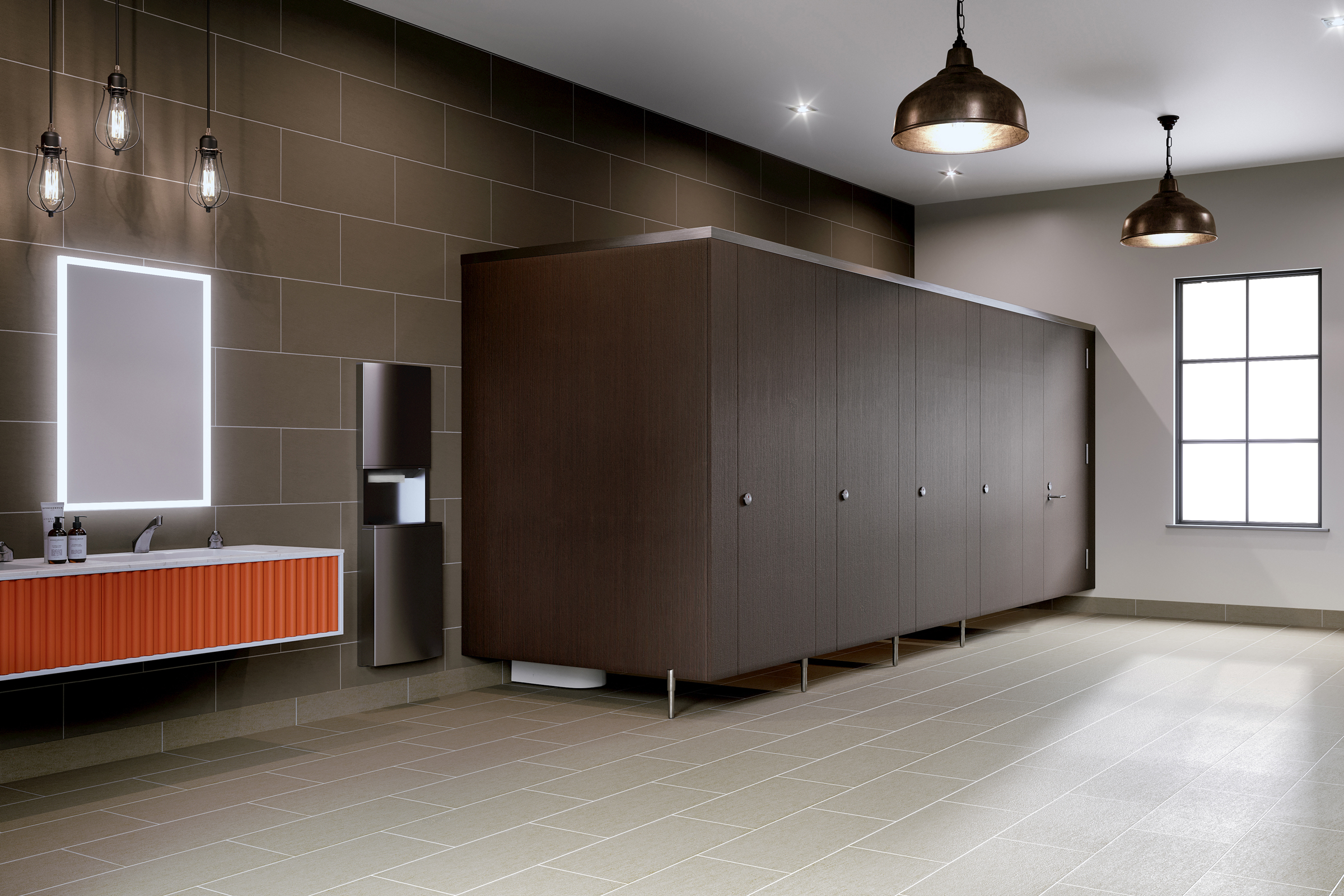
To provide a larger physical barrier between patrons, use increased-height toilet compartments and urinal screens. Photo courtesy of Bobrick Washroom Equipment
While restroom cubicles and partitions aren’t a rare sight by any means—indeed, you’d be hard pressed to find a communal public bathroom without them—not all partitions prevent the spread of germs with the same efficacy.
Toilet cubicles that feature large gaps at the floor and ceiling, for example, only stop some airborne particles from dispersing into the rest of the room, whereas full height bathroom cubicles that extend from ceiling to floor completely prevent airborne particles from entering adjacent stalls and other washroom spaces. Adding dividers between urinals can further reduce the spread of airborne pathogens.
Bobrick recently released bathroom cubicles and toilet partitions, which provide privacy along with durability and improved hygiene. All of their Traditional Partition systems are available in a range of easily cleanable materials while their PRIVADA line of cubicles and partitions may be equipped with hands-free latches to further reduce germ transfer.
Partitions are ideal for schools and universities, mass transit, standard offices, and industrial facilities. Bobrick cubicles and partitions are made-to-order. You start by selecting a system style, followed by material and height options. More specifications like patterns and woodgrains can also be added.
10. Select a sleek and sustainable shower drain.
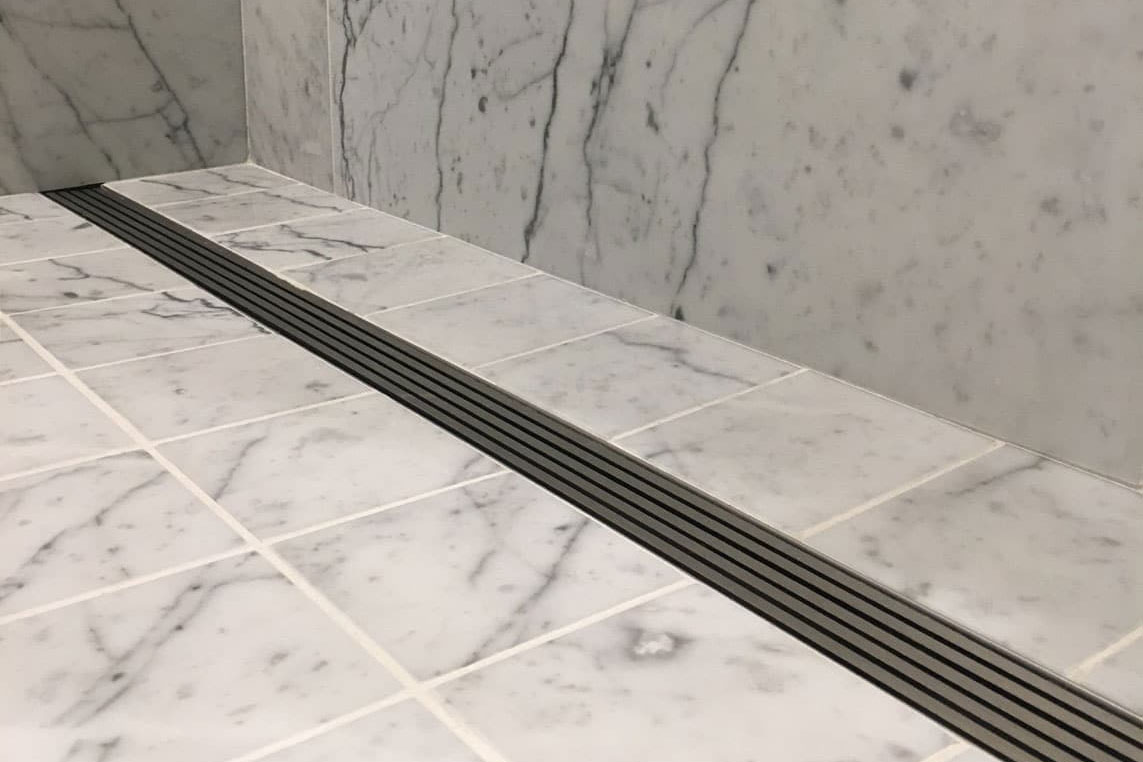
QuickDrain USA’s sleek shower drains can easily modernize any bathroom with a quick application process. Photo courtesy of Oatey Co.
As previously mentioned, showers are a common place for moisture to accumulate, making them highly susceptible to mold and mildew growth. In addition to a high-efficiency exhaust fan, this can be mitigated in part through selecting the right type of shower system and drain.
Curbless showers equipped with linear drains are amongst the best solutions when it comes to designing hygienic bathrooms. QuickDrain—a brand under the Oatey Co. family of brands—offers a variety of linear drains with fully sloped troughs that promote efficient water drainage, minimizing the risk of slipping, mold growth, and bacteria accumulation.
Because linear drains can be installed along the perimeter of a shower pan instead of in the center, larger format tiles may be used for the shower floor, reducing the amount of grout lines and joints, which in turn reduces mold and bacteria breeding grounds. All QuickDrain ProLine and ShowerLine linear drains are fashioned from marine-grade stainless steel, making them ideal for environments with strict hygiene requirements.
Samantha Stevens contributed to this article.

